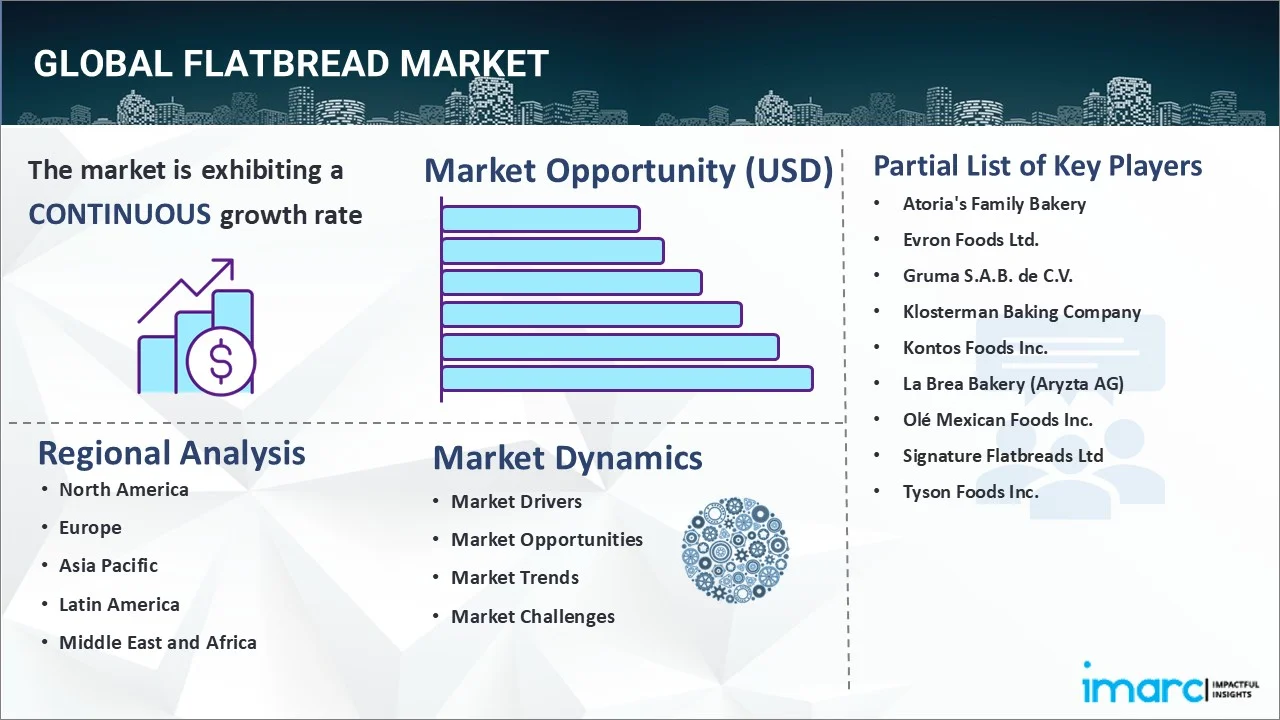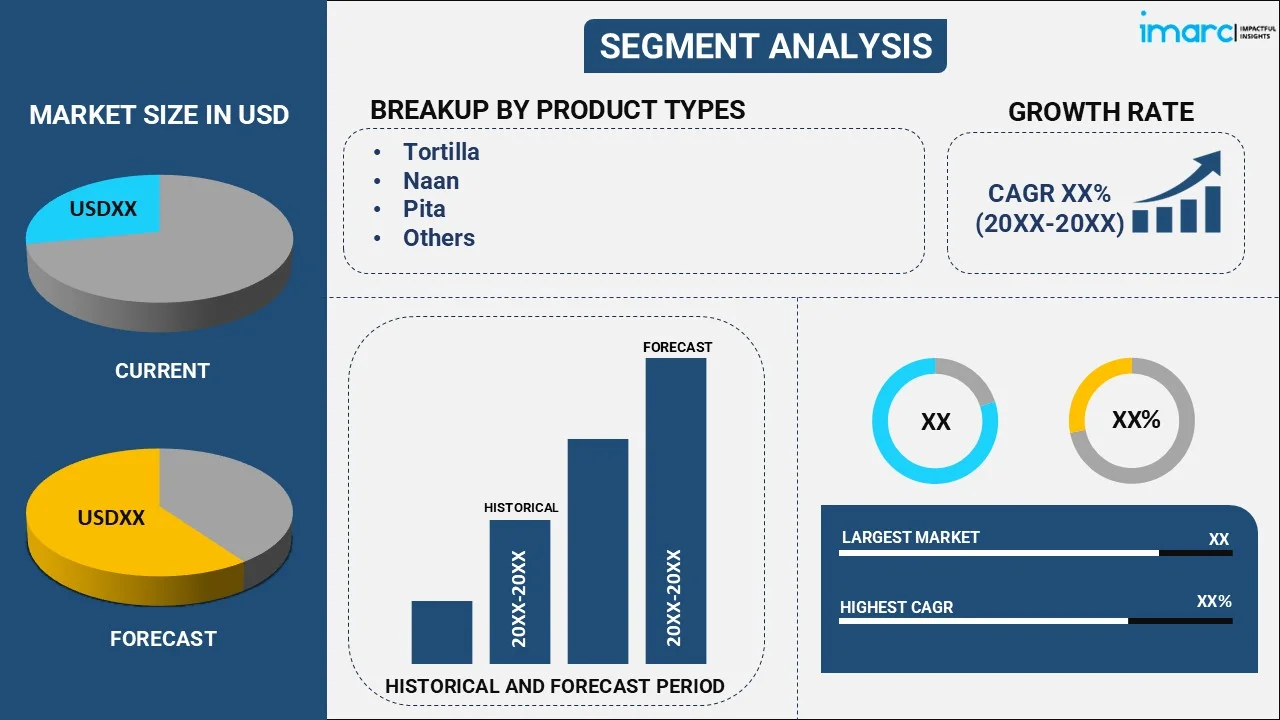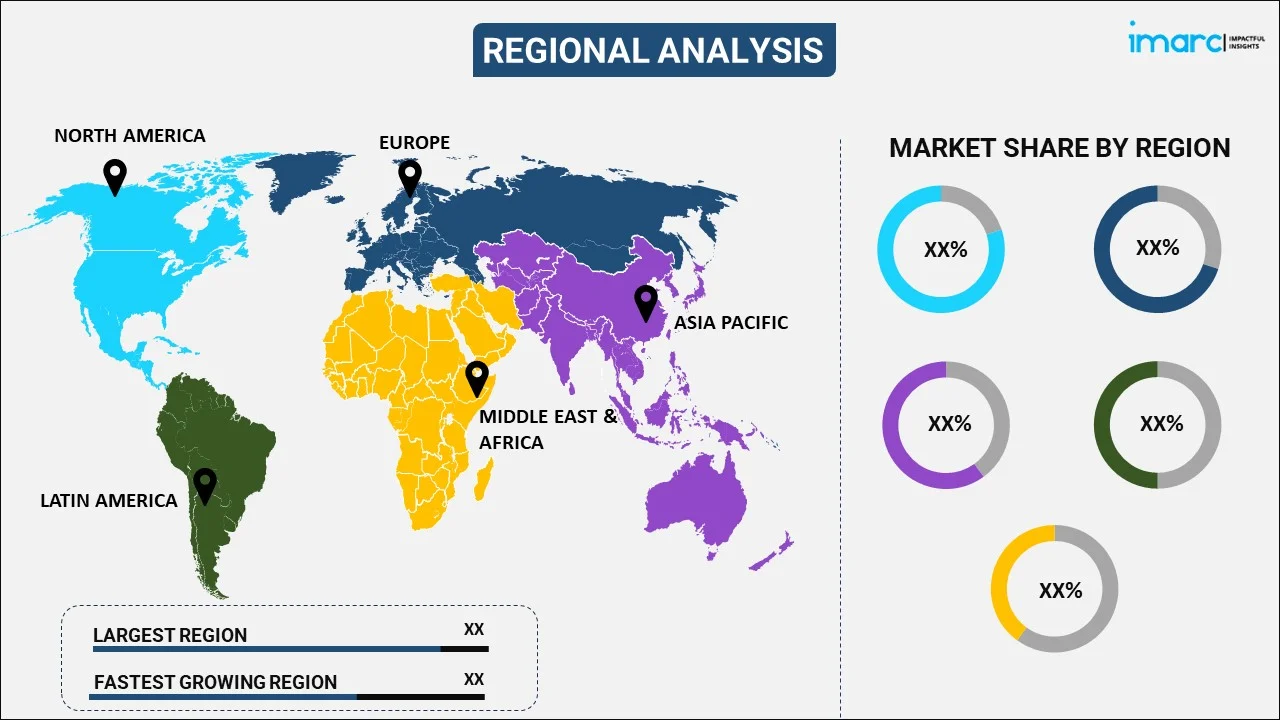
Flatbread Market Report by Product Type (Tortilla, Naan, Pita, Focaccia, Fry Bread, and Others), Distribution Channel (Business-to-Business, Business-to-Consumer), and Region 2025-2033
Global Flatbread Market:
The global flatbread market size reached USD 48.1 Billion in 2024. Looking forward, IMARC Group expects the market to reach USD 75.6 Billion by 2033, exhibiting a growth rate (CAGR) of 4.88% during 2025-2033. The rising health consciousness, emerging popularity of ethnic foods, growing product innovations, and the increasing awareness of global cuisines are primarily driving the market's growth.
|
Report Attribute
|
Key Statistics
|
|---|---|
|
Base Year
|
2024
|
|
Forecast Years
|
2025-2033
|
|
Historical Years
|
2019-2024
|
|
Market Size in 2024
|
USD 48.1 Billion |
|
Market Forecast in 2033
|
USD 75.6 Billion |
| Market Growth Rate 2025-2033 | 4.88% |
Flatbread Market Analysis:
- Major Market Drivers: The shifting inclination toward a healthy diet, owing to the increasing health consciousness amongst consumers and the growing awareness regarding the high nutritional value of flatbread, is majorly driving the market growth. Additionally, the rising consumption of ready-to-eat (RTE) items, such as flatbread, due to hectic lifestyles and busy working schedules, is acting as another growth-inducing factor.
- Key Market Trends: The extensive usage of effective packaging and sorbates and benzoates as standard preservatives by manufacturers to inhibit yeast, water activity, and moisture for extending the shelf life of flatbread is supporting the market growth. Moreover, significant technological advancements, such as the employment of new refrigeration solutions and modern bread-baking concepts, are propelling the market growth.
- Competitive Landscape: Some of the prominent flatbread market companies include Atoria's Family Bakery, Evron Foods Ltd., Gruma S.A.B. de C.V., Klosterman Baking Company, Kontos Foods Inc., La Brea Bakery (Aryzta AG), Olé Mexican Foods Inc., Signature Flatbreads Ltd, and Tyson Foods Inc., among many others.
- Geographical Trends: According to the flatbread market dynamics, flatbreads are popular in North America due to the multicultural population and increasing interest in diverse cuisines, including Mediterranean, Middle Eastern, and Indian. Moreover, flatbreads like pita, focaccia, and lavash are traditional in various European cuisines. Their popularity in local and regional diets drives demand.
- Challenges and Opportunities: High competition among key players and fluctuating prices of raw materials are hampering the market's growth. However, introducing new flavors, ingredients, and ethnic varieties can capture consumer interest and differentiate products in a crowded market.

Flatbread Market Trends:
Rising Demand for Healthy Foods
Consumers are increasingly looking for convenient meal options. For instance, according to IMARC, the global convenience food market size reached US$ 484.6 Billion in 2023. Looking forward, IMARC Group expects the market to reach US$ 782.7 Billion by 2032, exhibiting a growth rate (CAGR) of 5.47% during 2024-2032. Flatbreads are often perceived as healthier alternatives to traditional bread due to their typically lower fat content and simpler ingredient lists. These factors are expected to propel the flatbread market in the coming years.
Growing Popularity of Plant-Based Ingredients
As more consumers adopt vegan and plant-based diets, there is a rising demand for flatbreads made without animal products. For instance, according to a poll conducted by Rakuten Insight in February 2024, more than 48% of Indian respondents indicated they had consumed plant-based food products due to worries about animal welfare in food production. Furthermore, around 46% choose to pursue a vegetarian or vegan diet. This has led manufacturers to develop flatbreads that use plant-based ingredients, appealing to this growing demographic. These factors further positively influence the flatbread market forecast.
Product Innovations
There is a rising demand for whole grain and high-fiber flatbreads due to their perceived health benefits. Various manufacturers are launching low-calorie and high-fiber flatbreads. For instance, in January 2023, Flagship Food Group introduced Carb Cutting tortillas under the labels La Tortilla Factory and Tortilla King. The new tortilla range consists of a zero-carb tortilla, a 4-gram net-carb flour tortilla, and a 4-gram net-carb whole wheat tortilla. These products appeal to health-conscious consumers who are looking for more nutritious alternatives to traditional flatbreads, thereby boosting the flatbread market revenue.
Global Flatbread Industry Segmentation:
IMARC Group provides an analysis of the key trends in each sub-segment of the global flatbread market report, along with forecasts at the global, regional, and country levels from 2025-2033. Our report has categorized the market based on product type and distribution channel.
Breakup by Product Type:

- Tortilla
- Naan
- Pita
- Focaccia
- Fry Bread
- Others
The report has provided a detailed breakup and analysis of the flatbread market based on the product type. This includes tortilla, naan, pita, focaccia, fry bread, and others. According to the report.
According to the flatbread market outlook, tortillas are highly versatile and used in a variety of dishes, such as wraps, tacos, quesadillas, and burritos, making them a staple in many households and food service establishments. Moreover, as Indian cuisine gains popularity worldwide, naan, a traditional Indian flatbread, is increasingly being featured on menus in both ethnic and mainstream restaurants. Apart from this, pita bread is commonly used for sandwiches, wraps, and as a base for various dips and spreads, such as hummus and tzatziki. Furthermore, focaccia’s artisanal nature and its association with gourmet dining boost its demand, particularly in upscale restaurants and bakeries.
Breakup by Distribution Channel:
- Business-to-Business
- Business-to-Consumer
- Hypermarkets and Supermarkets
- Specialty and Convenience Stores
- Bakeries
- Online Stores
The report has provided a detailed breakup and analysis of the flatbread market based on the distribution channel. This includes business-to-business, and business-to-consumer (hypermarkets and supermarkets, specialty and convenience stores, bakeries, and online stores).
According to the flatbread market overview, various business-to-business distribution channels, including restaurants, cafes, and fast-casual dining establishments, often use flatbreads in a variety of dishes, such as wraps, pizzas, and sandwiches. They look for bulk suppliers who can provide consistent quality and reliable delivery. Moreover, consumers purchase flatbread from supermarkets and grocery stores. The variety available—ranging from traditional options like pita and naan to artisanal and health-oriented varieties—drives consumer interest, further propelling the demand from business to consumer establishments.
Breakup by Region:

- North America
- United States
- Canada
- Asia-Pacific
- China
- Japan
- India
- South Korea
- Australia
- Indonesia
- Others
- Europe
- Germany
- France
- United Kingdom
- Italy
- Spain
- Russia
- Others
- Latin America
- Brazil
- Mexico
- Others
- Middle East and Africa
The report has also provided a comprehensive analysis of all the major regional markets, which include North America (the United States and Canada); Europe (Germany, France, the United Kingdom, Italy, Spain, Russia, and others); Asia Pacific (China, Japan, India, South Korea, Australia, Indonesia, and others); Latin America (Brazil, Mexico, and others); and the Middle East and Africa.
According to the flatbread market statistics, there is significant demand for a variety of flatbreads including tortillas, pita, and naan in North America. Tortillas are particularly popular due to the prevalence of Mexican and Tex-Mex cuisines. Moreover, European countries have a strong tradition of consuming various types of flatbreads. In Mediterranean countries flatbreads, such as pita and focaccia, are staples. Central and Eastern Europe also have rich traditions of flatbread. Apart from this, flatbread is a dietary staple in many Middle East and African countries. Products like pita, lavash, and khubz are integral to daily meals. The region has a high consumption rate of these products.
Competitive Landscape:
The market research report has provided a comprehensive analysis of the competitive landscape. Detailed profiles of all major market companies have also been provided. Some of the key players in the market include:
- Atoria's Family Bakery
- Evron Foods Ltd.
- Gruma S.A.B. de C.V.
- Klosterman Baking Company
- Kontos Foods Inc.
- La Brea Bakery (Aryzta AG)
- Olé Mexican Foods Inc.
- Signature Flatbreads Ltd
- Tyson Foods Inc.
(Please note that this is only a partial list of the key players, and the complete list is provided in the report.)
Flatbread Market Recent Developments:
- May 2024: Baked Earth Bakery introduced its original garlic and coriander naan bites to supermarket giant Asda. They are suitable for vegans and cook in the oven for two to three minutes or under the grill for one to two minutes. They are also ideal for home freezing.
- March 2024: King Arthur Baking Company unveiled its newest line of premium mixes, Savory Bread Mix Kits. These mix kits provide a unique baking experience for bakers of all skill levels, with flexible options including Crisp & Airy Focaccia, and Perfectly Tender Flatbread.
- January 2024: Cracker manufacturer Partners, A Tasteful Choice Co. introduced a range of sourdough flatbread crackers. The crackers are available in three varieties: sea salt, rosemary, and garlic herb. They are produced from vegan, all-natural, non-GMO Project-verified ingredients.
Flatbread Market Report Scope:
| Report Features | Details |
|---|---|
| Base Year of the Analysis | 2024 |
| Historical Period | 2019-2024 |
| Forecast Period | 2025-2033 |
| Units | Billion USD |
|
Scope of the Report |
Exploration of Historical Trends and Market Outlook, Industry Catalysts and Challenges, Segment-Wise Historical and Predictive Market Assessment:
|
| Product Types | Tortilla, Naan, Pita, Focaccia, Fry Bread, Others |
| Distribution Channels |
|
| Region Covered | Asia Pacific, Europe, North America, Latin America, Middle East and Africa |
| Countries Covered | United States, Canada, Germany, France, United Kingdom, Italy, Spain, Russia, China, Japan, India, South Korea, Australia, Indonesia, Brazil, Mexico |
| Companies Covered | Atoria's Family Bakery, Evron Foods Ltd., Gruma S.A.B. de C.V., Klosterman Baking Company, Kontos Foods Inc., La Brea Bakery (Aryzta AG), Olé Mexican Foods Inc., Signature Flatbreads Ltd, Tyson Foods Inc., etc. |
| Customization Scope | 10% Free Customization |
| Post-Sale Analyst Support | 10-12 Weeks |
| Delivery Format | PDF and Excel through Email (We can also provide the editable version of the report in PPT/Word format on special request) |
Key Questions Answered in This Report:
- How has the global flatbread market performed so far and how will it perform in the coming years?
- What has been the impact of COVID-19 on the global flatbread market?
- What are the key regional markets?
- What is the breakup of the market based on the product type?
- What is the breakup of the market based on the distribution channel?
- What are the various stages in the value chain of the industry?
- What are the key driving factors and challenges in the industry?
- What is the structure of the global flatbread market and who are the key players?
- What is the degree of competition in the industry?
Key Benefits for Stakeholders:
- IMARC's report offers a comprehensive quantitative analysis of various market segments, historical and current market trends, market forecasts, and dynamics of the flatbread market from 2019-2033.
- The research study provides the latest information on the market drivers, challenges, and opportunities in the global flatbread market.
- The study maps the leading, as well as the fastest-growing, regional markets. It further enables stakeholders to identify the key country-level markets within each region.
- Porter's five forces analysis assists stakeholders in assessing the impact of new entrants, competitive rivalry, supplier power, buyer power, and the threat of substitution. It helps stakeholders to analyze the level of competition within the flatbread industry and its attractiveness.
- The competitive landscape allows stakeholders to understand their competitive environment and provides insight into the current positions of key players in the market.
Need more help?
- Speak to our experienced analysts for insights on the current market scenarios.
- Include additional segments and countries to customize the report as per your requirement.
- Gain an unparalleled competitive advantage in your domain by understanding how to utilize the report and positively impacting your operations and revenue.
- For further assistance, please connect with our analysts.
 Inquire Before Buying
Inquire Before Buying
 Speak to an Analyst
Speak to an Analyst
 Request Brochure
Request Brochure
 Request Customization
Request Customization




.webp)




.webp)












